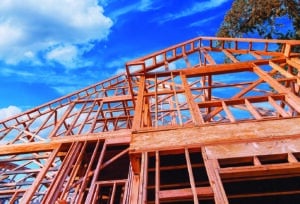A bump in construction of new single-family homes last month didn’t help homebuilders feel any better about their business prospects, according to the latest data from the National Association of Home Builders.
The latest edition of the association’s Wells Fargo Housing Market Index showed builder sentiment fell for the ninth straight month in September as elevated interest rates, persistent building material supply chain disruptions and the resulting high home prices continued to bite into their sales and profits, the NAHB said.
All three index components posted declines in September: Current sales conditions dropped three points to 54, sales expectations in the next six months declined one point to 46 and traffic of prospective buyers fell one point to 31.
“Buyer traffic is weak in many markets as more consumers remain on the sidelines due to high mortgage rates and home prices that are putting a new home purchase out of financial reach for many households,” NAHB Chairman Jerry Konter, a home builder and developer from Savannah, Ga., said in a statement. “In another indicator of a weakening market, 24% of builders reported reducing home prices, up from 19% last month.”
At a national level, homebuilder confidence in the market for newly built single-family homes fell three points in September to 46, the lowest level since May 2014 with the exception of the spring of 2020. The index’s three-month moving average for the Northeast fell five points to 51.
Derived from a monthly survey that NAHB has been conducting for more than 35 years, the NAHB/Wells Fargo HMI gauges builder perceptions of current single-family home sales and sales expectations for the next six months as “good,” “fair” or “poor.” The survey also asks builders to rate traffic of prospective buyers as “high to very high,” “average” or “low to very low.” Scores for each component are then used to calculate a seasonally adjusted index where any number over 50 indicates that more builders view conditions as good than poor.
NAHB Chief Economist Robert Dietz said in a statement that the survey showed more than half of homebuilders are using mortgage rate buydowns, free amenities and price cuts to try and drum up business.
The pessimism came as the Census Bureau reported a jump in new single-family construction that National Association of Realtors Chief Economist Lawrence Yun called “surprising.”
The 3.4 percent seasonally-adjusted increase in nationwide single-family starts broke a five-month stretch of month-over-month declines. In the Northeast, single-family starts were down 14.3 percent month-over-month and 11.8 percent year-over-year, seasonally adjusted.
“The inventory of unsold homes and canceled contracts accumulated due to higher mortgage rates. However, the latest month’s increase is implying that builders still see profit opportunities even as they concede on prices,” Yun said. “Material prices, including that of lumber, have been moderating, and fully completed homes are selling fast. Unfinished homes still under construction are the ones sitting on the market for long periods.”
Still, Zillow economist Nicole Bachaud noted that single-family starts were down slightly year-over-year and permits were down annually since the first time since the start of the pandemic and were lower than many economists’ predictions.
“While demand is slowing for the time being, largely due to affordability obstacles, demographic factors will contribute to sustained demand for housing for years to come, and with the current trend of building activity slowing, low inventory will continue to push long term price growth up and affordability down,” Bachaud said in a statement.
The Census Bureau data showed a much better environment for nationwide multifamily starts: a seasonally adjusted 28.6 percent jump month-over-month and a 31 percent hike year-over-year. Multifamily permits were down a seasonally-adjusted 18.5 percent month-over-month and 14.5 percent year-over-year.
Regionally, combined single-family and multifamily starts were 4.6 percent higher in the Northeast year-to-date in August, while permits were 3.1 percent down.
“As demand for rental homes continues to increase due to waning affordability in the for-sale market, builders are shifting with the winds and meeting consumers where they are,” Bachaud said.
Still, no one should expect the bump in multifamily construction to help ease the nation’s tight rental and for-sale markets any time soon, Yun said.
“There was a housing shortage of around 5 million homes before the onset of the pandemic. That shortage is not going away soon,” he said. “The near-term single-family outlook is complicated due to high mortgage rates. But the long-term outlook for homebuilders is bright due to the need to build more to fully relieve the housing shortage.”







